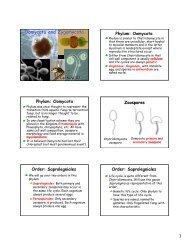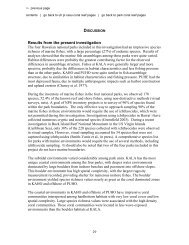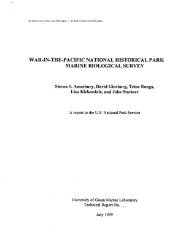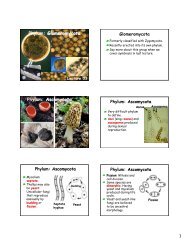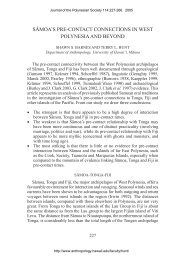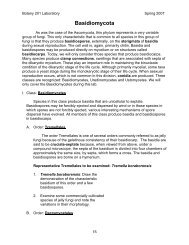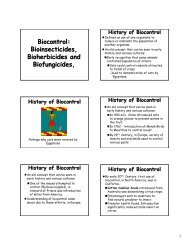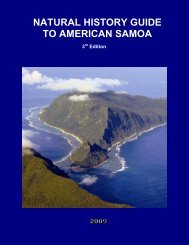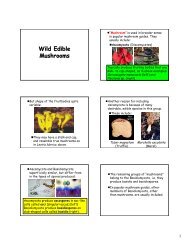american samoa - University of Hawaii at Manoa Botany Department
american samoa - University of Hawaii at Manoa Botany Department
american samoa - University of Hawaii at Manoa Botany Department
- No tags were found...
Create successful ePaper yourself
Turn your PDF publications into a flip-book with our unique Google optimized e-Paper software.
ecome dominant if there is a nearby seed source since this plant is presently absent from themarsh.AQUATIC FISH AND INVERTEBRATESGeneralOn November 3, 1999, Charles Chong <strong>of</strong> the PPCfield survey team made observ<strong>at</strong>ions <strong>of</strong> aqu<strong>at</strong>ic fishand invertebr<strong>at</strong>es along portions <strong>of</strong> Tapua Stream andits upland tributary, Lepa Stream. His observ<strong>at</strong>ionsare summarized in the following paragraphs.Aoa wetland contained a small estuary just upstream<strong>of</strong> the Tapua Stream mouth. The estuary was fed bysurface run<strong>of</strong>f from Tapua Stream and Lepa Stream.Puna Stream was completely dry during theNovember 3 survey; no flows were observed <strong>at</strong> itsconfluence with Tapua Stream.Lepa StreamTapua Stream was also dry for a short distancebetween Aoa wetland the base <strong>of</strong> upland slopes onthe south side <strong>of</strong> the wetland. The stream flowthrough one set <strong>of</strong> culverts just upstream <strong>of</strong> the TapuaStream mouth was less than 0.5 cfs during the survey.FishSmall estuary upstream <strong>of</strong> Tapua Stream mouthThe estuary inside Aoa wetland and inland portion <strong>of</strong> Tapua Stream contained nearly all <strong>of</strong> thefresh-w<strong>at</strong>er fishes known to American Samoa. Within the estuary, Mugil and Kuhlia spp. wereabundant as were other euryhaline fishes such as Periopthalmus.The amphidromous gobioids, Stenogobius genivitt<strong>at</strong>us and Eleotris spp., as well as fresh-w<strong>at</strong>erspecies Poecilia reticul<strong>at</strong>a and P. mexicana, were common in the estuary. Other gobies,however, were not seen anywhere in the wetland. Lower stream flow and intermittent streamflow conditions may have prevented the presence <strong>of</strong> other gobies.A few residents informed Charles Chong <strong>of</strong> the PPC survey team th<strong>at</strong> anguillids were presentin the upper reaches <strong>of</strong> Tapua Stream. Captive specimens, obtained by local residents,evidenced their presence in the stream. However, Chong observed no anguillids during thefield survey.Invertebr<strong>at</strong>esThe invertebr<strong>at</strong>es observed in Tapua Stream and Lepa Stream included the completecompliment <strong>of</strong> fresh-w<strong>at</strong>er molluscs, but only a portion <strong>of</strong> the crustaceans known to AmericanSamoa. Immedi<strong>at</strong>ely inland <strong>of</strong> the estuary, for example, two unidentified species <strong>of</strong> neritidsnails were abundant in Tapua Stream. Sisiwai and two other species were common. Alongupland Lepa Stream, only the larger smooth species <strong>of</strong> neritid snails was found.American Samoa Wetland/Stream Restor<strong>at</strong>ion and Enhancement PlanFebruary 2001, Aoa Wetland, Page 4-8



